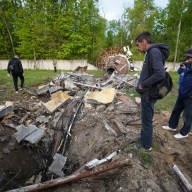From George W. Bush’s first mention of WMDs to the triumphant killing of Osama bin Laden:
Sept. 11, 2001:
Terrorist attacks against the United States: Two planes crash into the twin towers and one hits the Pentagon, killing nearly 3,000 people.
Oct. 7, 2001:
The U.S. and the U.K. begin war in Afghanistan with Operation Enduring Freedom, launching ground forces in Kabul to oust the Taliban from power.
Jan. 29, 2002:
In his State of the Union address, President George W. Bush says that Iraq is part of the “axis of evil,” and the nation is allied with terrorists and poses a serious threat to the U.S. Bush would later say Iraq was harboring weapons of mass destruction.
March 19, 2003:
Bush leads U.S. invasion of Iraq. Some countries decry the invasion as unilateral and argue that the threat of weapons of mass destruction is unfounded and misrepresented.
April 9, 2003:
Baghdad falls under America’s control, overthrowing Saddam Hussein’s rule inside the capital. In a symbolic moment, U.S. troops topple a statue of Hussein.
Dec. 13, 2003:
Saddam Hussein is found by U.S. military personnel and is sentenced to death by hanging.
March 31, 2004:
Four mercenary soldiers, working with a company called Blackwater as private security guards, are brutally killed in Fallujah. Their bodies are beaten, dragged through the streets, and hung — the images of their deaths puts a spotlight on the controversial U.S. decision to use privately paid military contractors in Iraq.
Sept. 7, 2004:
By this point, 1,000 U.S. soldiers have lost their lives in Iraq.
April 2005:
The CIA’s top weapons
inspector announced that after an exhaustive search, they found no weapons of mass destruction in Iraq.
Dec. 15, 2005:
The first parliamentary elections in Iraq are being held since the capture of Hussein.
Nov. 8, 2006:
Secretary of Defense Donald H. Rumsfeld resigns from his position after reports break that Iraqi detainees were being abused at Abu Ghraib prison. Public outrage followed after photos were leaked that showed prisoners subject to torture and forced into
humiliating positions.
June 7, 2007:
The al-Qaeda leader in Iraq, Abu Musab al-Zarqawi, is killed in an airstrike.
Feb. 27, 2009:
President Barack Obama vows that all the U.S. combat soldiers in Iraq, except for a transitional force of 35,000 to 50,000 troops, will be withdrawn by Aug. 31, 2010.
May 2, 2011:
9/11 mastermind Osama bin Laden is killed by Navy SEALs in a compound where he had been hiding in Abbottabad, Pakistan. U.S. citizens triumphant with glee.
June 22, 2011:
Obama announces that 10,000 U.S. troops would be withdrawn by the end of 2011 in Afghanistan and an additional 23,000 troops would leave the country by the summer of 2012.
Aug. 6, 2011:
Taliban fighters in Afghanistan shoot down a CH-47 Chinook, killing 30 Navy SEALs — some belonging to the same raid that killed bin Laden. The incident marks the deadliest single loss for American forces in the war.

















